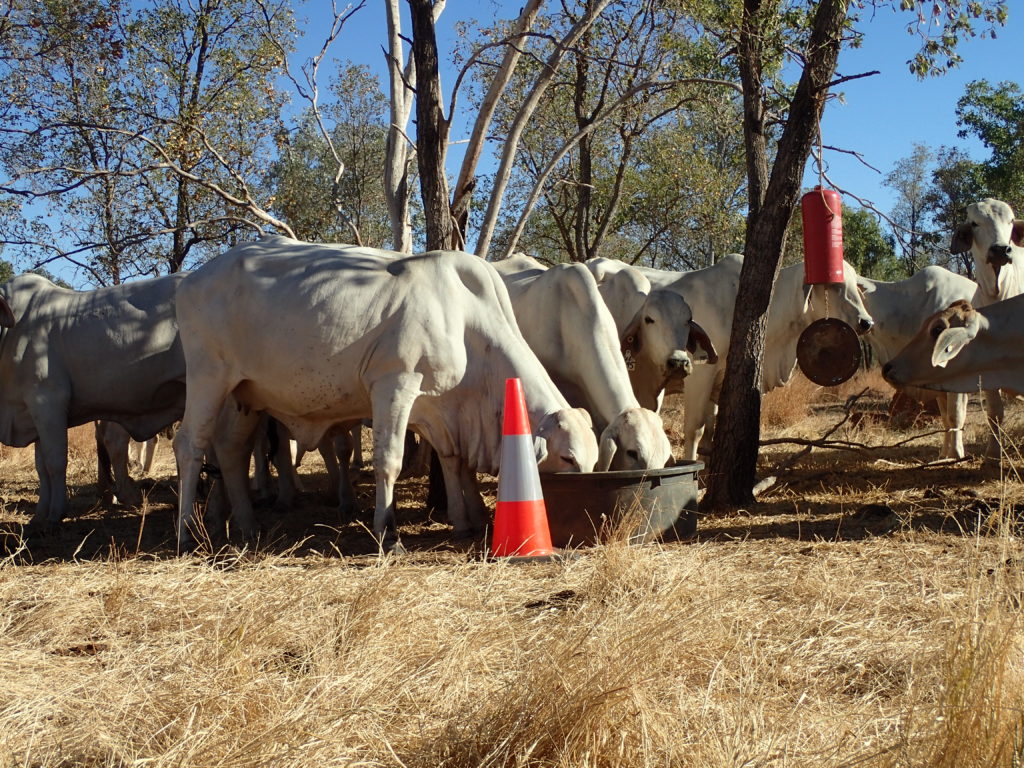Grazing with self herding to improve performance of pastoral cattle
Uneven use of the landscape has long been a concern for producers in the extensively managed beef production systems of northern Australia. Historically, the solution to this problem has required costly infrastructure development, with other less expensive options, such as alternating access to water sources, proving to be unreliable in some circumstances. The self herding approach focuses on encouraging animals to change their grazing patterns using techniques based on behavioural science, nutrition, physiology and ecology as opposed to deprivation or restriction.
A trial on the Northern Territory Government owned Victoria River Research Station (also known as Kidman Springs) aims to test whether self herding techniques can be used to create new grazing circuits within a paddock, thus creating a form of rotational grazing that does not rely on permanent fencing.
The trial uses feed attractants paired with signals to encourage cattle to make choices in response to positive behavioural and/or nutritional feedback. A mobile “attractant station” is used to achieve managed movements of cattle throughout the landscape. The attractant station comprises four small feed tubs paired with a visual cue (witches hats placed on a nearby road or firebreak) and an audible cue (a wind chime placed in a tree near the attractant station). Each tub has a small amount of a supplementary feed added to it. Three of the tubs contain familiar feed items (e.g. urea, coarse salt and “Bruce’s Brew”, which is a mixture of locally-sourced wood ash and charcoal). The fourth tub is reserved for the intermittent placement of highly attractive energy-rich “jackpots” such as shipper pellets or molasses. The jackpots are paired with a unique sound cue, such as a whistle blown loudly at the time the jackpot is delivered. The intermittent use of jackpots keeps the cattle highly motivated to return to the attractant station on the off-chance that a particularly attractive food reward might be there.

The frequency and distance that the attractant station is moved around the paddock is very flexible. During busy times, the attractant station can be left for several days before being moved.
Many producers already move lick around their paddocks, but this method amplifies that approach by offering a variety of attractants and using intermittent and unpredictable timing. This has the effect of increasing interest for a broader range of animals in a mob.
Ten heifers in the trial are wearing GPS collars that ping at hourly intervals. The location data is used to generate day and night time maps showing how the animals are using the paddock over time in relation to the attractants and other factors like surface water and recently burnt areas.

The animations below show the locations of the cattle at hourly intervals using the cumulative GPS data. One shows the day-time patterns and the other shows the night-time patterns. The colour shading indicates the amount of use experienced by different parts of the paddock, with blue being light use, grading through to red which is high usage.
The animations show that during the day the cattle tend to rest at the water point until late afternoon and then move out to graze through the night. Once the rains start in November 2018, you can see that the cattle spent more time grazing during the day. This is because the pastures had higher moisture content and surface water became available throughout the paddock.
The self herding project aims to:
- Demonstrate that rangeland self herding techniques provide a practical approach to influence grazing locations of cattle within paddocks, allowing a form of rotational grazing without fencing subdivision.
- Quantify changes in biomass across extensive grazing systems and provide producer guidelines to achieve optimum grazing management.
- Conduct a cost-benefit analysis of this technique in comparison to the expenditure required to achieve even landscape utilisation with other infrastructure development options.
Duration:
2017-2019
Contacts:
Dr Dionne Walsh (formerly NT Government)
Dr Dean Revell, email: dean@revellscience.com.au
Bruce Maynard, email: bruce.maynard@bigpond.com
Project Partners:
The project is funded by Meat and Livestock Australia with in-kind contributions from Northern Territory Department of Industry, Tourism and Trade, Revell Science, Stress Free Stockmanship, Territory Natural Resource Management, Rangelands Natural Resource Management and Oxley Grazing.
Final Report
B.GBP.0025 Grazing with Self Herding (PDF, 4.5 MB)
Additional information:
- Self Herding Australian Rangeland Society Poster 2019 (PDF, 3 MB)
- Self Herding abstract for the Northern Beef Research Update Conference (PDF, 200 KB)
- Testing “Rangelands Self Herding” at Kidman Springs (PDF, 3 MB)
- Self herding website (Maynard & Revell)
- Self herding trial progresses at Victoria River Research Station (NT Govenrment)
- Kidman cattle get their marching orders in self herding trial (MLA)
- Self herding for landscapes and profit update (MLA)
- Cattle encouraged to herd themselves in Northern Territory trial (ABC News)
- Trails begin to demonstrate effectiveness of self herding (Rangelands NRM)
- Self herding success (FutureBeef)